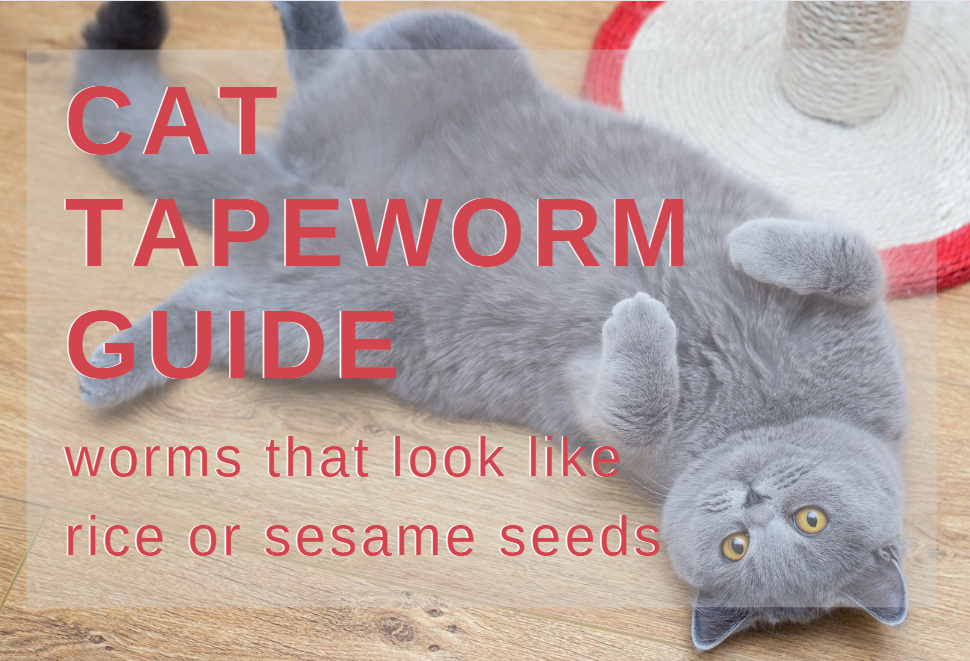Tapeworms: Worms in Cats that Look Like Rice
It’s very likely your cat has tapeworms if your cat has little worms that look like rice or sesame seeds stuck in its fur near its bum or tail (or where it sleeps or in its feces).
Tapeworms are long, flat parasites that grow within your cat after latching onto its intestines. They absorb nutrients from the food your cat eats as it moves through the intestines. Tapeworms do not feed on blood. As the tapeworm matures, tiny tapeworm sections (called proglottids) break off of it and pass through the intestines and out the cat’s anus. Proglottids are filled with tapeworm eggs; they’re essentially little egg sacs being deposited all over your home.
What dried tapeworm segments (right) look like compared to rice grains (lower left) and roasted sesame seeds (top left). Tapeworm proglottids are smaller than both sesame seeds and rice grains. Before they dry out, they look more like the rice grains in color and size and texture. Before tapeworms segments dry out they are a white/cream color and are mushy.
How To Tell If Your Cat Has Tapeworms
As mentioned above, you may notice white, cream-colored, or yellow grain or seed-like segments (proglottids) on or near your cat's anus. These segments often are compared to rice, sesame seeds, or small white worms, and they are filled with tapeworm eggs. Tapeworm segments start off white and mushy when they leave the body and become more yellow and hardened as they dry out as time passes. You may also notice these tapeworm segments (essentially tapeworm eggs) in your bed, your cat’s bed or in other common areas they like to sleep or lounge.
Sound like your situation? You can get over-the-counter cat tapeworm dewormer pills, but please continue on to the flea section below since it is very likely you will need to also treat your pet(s) for fleas, too, so that the tapeworm cycle doesn’t endlessly repeat itself.
Tapeworm Symptoms in Cats
Besides seeing the tapeworm segments (aka tapeworm egg sacs) on your cat or around your home, you may not notice any other tapeworm symptoms. Most adult cats don't display symptoms, but it is still important to cure your cat of these parasites so the condition doesn't worsen. Some cats may experience itching near their anus, or may vomit tapeworms, although these tapeworm symptoms are more common in dogs who are infected, not cats.
Are Dried Tapeworm Segments Contagious?
Proglottids (dried out or not) cannot reinfect your cat or other pets if they get eaten, because they require an intermediate host (almost always fleas!) to mature inside first. Once a cat eats a tapeworm-contaminated flea (often while grooming), it becomes infested— more on this in a moment.
How Do Cats Get Tapeworms?
There are two common ways cats can get tapeworms: From ingesting fleas while grooming, or from eating an animal that was infected with tapeworms like mice, birds, rabbits or squirrels. The most common cause of Dipylidium caninum tapeworms in cats are fleas. While in the intestines, tapeworms detach segments filled with eggs called gravid proglottids. They are excreted through the feces. Flea larvae consume the excreted proglottids, and thus consume the tapeworm egg sacs. The tapeworms grow with the flea larvae as the mature to adult fleas. Fleas feed off of blood and commonly attack cats and dogs, as well as other animals like mice and other rodents. Cats who have fleas may consume a tapeworm-infected flea while grooming, and become infected with a tapeworm. As the tapeworm grows within the cat, it releases proglottids into your cat's feces, potentially starting this tapeworm to flea cycle all over again if fleas or rodents are present. Over-the-counter tapeworm medication can be bought in stores and online.
Cats who are infected with Taenia taeniaeformis tapeworms are typically infected by eating flea-infested rodents. Nonprescriptive flea treatment is also available online.
Flea Symptoms in Cats
Cats with fleas are likely to itch around their face, head and neck. This irritation, itching and scratching can lead to bumpy, crusty sores and lesions. The back of the neck and base of the tail that are often irritated by fleas (especially because cats cannot easily reach these areas). Cats with fleas may also experience hair loss or hairballs from excessive grooming.
Can I Get Tapeworms From My Cat?
If you consume a tapeworm-infested flea on accident, you could become infected. This is very rare, and when it does occur, it is usually in small children (young children have a tendency to put found items or dirty hands in their mouths).
How Did My Indoor Cat Get Tapeworms?
If your cat has tapeworms, it is imperative to treat them to get rid of these parasites. Be sure to treat them for both fleas and tapeworms, so the cycle doesn't begin all over again. You can get prescriptive or over-the-counter (OTC) tapeworm medication and flea medication to clear your cat of both of these parasites. Be cautious when using OTC flea collars for dogs or cats, or other over-the-counter flea medication— some pets get seizures from them.
On the left is a roasted sesame seed, on the right is a dried tapeworm segment (proglottid). When they are not dried out, these cat tapeworm egg sacs look like white rice.
How To Prevent Your Cats From Getting Tapeworms
To prevent our cats from getting tapeworms, keep them up-to-date on flea prevention medications and away from rodents and rotting garbage. Clean your home thoroughly after treating your cat for tapeworms to help prevent reinfection. Vacuuming your home and cleaning their bedding or favorite spots will help clear your house of tapeworm segments and potentially even fleas. I recommend vacuuming multiple times. Be sure to rid your home of fleas, or the tapeworm cycle will likely start over.
How Long Does It Take for Tapeworm Medicine to Work in Cats?
Luckily, tapeworm treatments work quickly, and only require two doses. Many people on a budget want to know how to get rid of tapeworms in cats without going to the vet, and this is how: The first initial dose of tapeworm dewormer starts working to breakdown the adult tapeworm so that your cat can pass it in its stool; often within 24 hours it will be passed in your cat’s feces. The second dose needs to be taken 2-4 weeks later to ensure that all of the tapeworm was passed and that any tapeworms that were in the larval stage during the first dose are killed off.
I always recommend that you take your pets to a veterinarian, but if you cannot afford it, you can get rid of tapeworms in cats without going to the vet by correctly using dewormer (that is specified for tapeworms) and treating your cat (and other pets and home) for fleas. Continue to treat your pets for fleas to ensure that infected fleas (hosts to tapeworms) cannot infect your pets again in the future. Never use medical product meant for dogs on cats, and be mindful of your cat’s weight when choosing medications like dewormer and flea medication.






